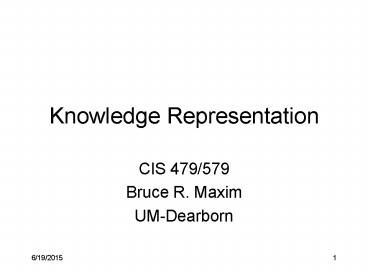Knowledge Representation - PowerPoint PPT Presentation
Title:
Knowledge Representation
Description:
Knowledge Representation CIS 479/579 Bruce R. Maxim UM-Dearborn Representation Set of syntactic and semantic conventions which make it possible to describe things ... – PowerPoint PPT presentation
Number of Views:161
Avg rating:3.0/5.0
Title: Knowledge Representation
1
Knowledge Representation
- CIS 479/579
- Bruce R. Maxim
- UM-Dearborn
2
Representation
- Set of syntactic and semantic conventions which
make it possible to describe things - Syntax
- specific symbols allowed and rules allowed
- Semantics
- how meaning is associated with symbol
arrangements allowed by syntax
3
Representation Types
- Relational databases
- Constraints
- Predicate logic
- Concept hierarchies
- Semantic networks
- Frames
- Conceptual Dependency
- Scripts
4
Types of Knowledge
- Objects
- both physical concepts
- Events
- usually involve time
- maybe cause effect relationships
- Performance
- how to do things
- META Knowledge
- knowledge about how to use knowledge
5
Stages of Knowledge Use
- Acquisition
- structure of facts
- integration of old new knowledge
- Retrieval (recall)
- roles of linking and chunking
- means of improving recall efficiency
6
Stages of Knowledge Use
- Reasoning
- Formal reasoning
- deductive theorem proving
- Procedural Reasoning
- expert system
- Reasoning by Analogy
- very hard for machines
- Generalization
- reasoning from examples
- Abstraction
- simplification
7
Knowledge Representation Issues
- Grain size or resolution detail
- Scope or domain
- Modularity
- Understandability
- Explicit versus implicit knowledge
- Procedural versus declarative knowledge
8
Advantages
- Declarative representation
- Store each fact once
- Easy to add new facts
- Procedural representation
- Easy to represent "how to do things"
- Easy to represent any knowledge not fitting
declarative format - Relatively easy to implement heuristic stuff on
doing thing efficiently
9
Attributes of Good KR Schemes
- Representational Adequacy
- works for all knowledge in problem domain
- Inferential Adequacy
- provides ability to manipulate structures to
desire new structures - Inferential Adequacy
- ability to incorporate additional information in
knowledge structures to help focus attention of
promising new directions
10
Attributes of Good KR Schemes
- Acquisitional Efficiency
- easy to add new knowledge
- Semantic Power
- Supports truth theory
- Provides for constraint satisfaction
- Can cope with incomplete or uncertain knowledge
- Contains some commonsense reasoning capability
11
Broad KR Questions
- Are there properties of objects so basic that
they occur in every domain? - If so what are they?
- At what level should knowledge be represented?
- Is there a good set of primitives into which all
knowledge can be broken down? - How can the relevant parts of a large knowledge
base be accessed when needed?
12
State Space Representation
- How can individual objects and facts be
represented? - How do you combine individual object descriptions
to form a representation of the complete problem
state? - How can the sequences of problem states that
arise be represented efficiently?
13
Two Approaches
- Use complete object descriptions that include
relations to other objects in the environment - Use predicate logic to express these kind of
relations - on(plant,table).
- under(table,window).
- in(table,room).
14
Frame Problem
- What (or how much) should be stored at each
node? - How do you distinguish between facts that change
from facts that do not change between frames? - Stated and another way, how do you decide how
much information to record as you move from
problem state to problem state?
15
Frame Problem
- The naive approach is to store complete state
descriptions and make changes to them each time a
node is updated - Disadvantage
- takes time to do
- descriptions can become large
- what happens when algorithm needs to backtrack
and undo changes?
16
Frame Problem
- Better solution is to not physically modify the
state description but merely record a list of
changes that should be made at this node - To get to the current state, you start at the
initial state and then apply the changes recorded - Backtracking will be easy, but state description
is complicated
17
Frame Problem
- Another alternative would be to modify the state
description but mark the changes made so they can
be undone when backtracking is required - If temporal relations (time) are involved things
will become regardless of the approach used
18
Searching Rule-bases
- Sequential search of a large rule-base is time
consuming and should be avoided if possible - Making use of rule indices and hash tables would
improve the efficiency - Using variables in rules can reduce the number of
rules































